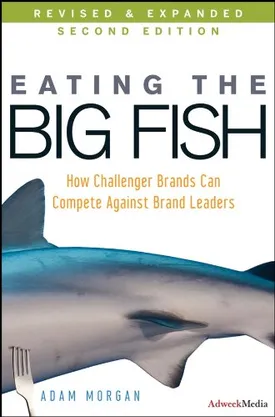Eating the Big Fish: How Challenger Brands Can Compete Against Brand Leaders by Adam Morgan
In Eating the Big Fish: How Challenger Brands Can Compete Against Brand Leaders, Adam Morgan lays out an eight-step strategy for challenger brands to successfully compete against market leaders. The book provides valuable insights for corporations and marketers alike, giving guidance on the best ways for smaller, lesser-known brands to make an impact in competitive industries.
The book begins by examining the environment in which challenger brands have to compete. This includes discussing the advantages enjoyed by market leaders and exploring why challengers often have difficulties competing with them. Examples of industries where market leaders have advantages are provided, and Morgan provides helpful guidance on how challenger brands can overcome obstacles they may face.
The core offering of the book is the Eight-Step Challenger Model, which is divided into pre-game and in-game stages. Through in-depth examples, Morgan examines the steps to success for challenger brands looking to break into the market and make an impact.
In the pre-game stage, Morgan discusses how challengers should start by focusing on their point of difference, clarifying their core purpose, and understanding where they need to play. This includes advice on how to develop an effective market entry plan, such as focusing on niche niches, segmenting opportunities, and identifying target customers and their needs. He also emphasizes that challenger brands must establish clear and consistent messages for their customers in order to stand out from their competitors.
The in-game stage focuses on how challengers can move from point of difference to distinctive brand. Morgan provides a framework for creating a clear and differentiating identity, as well as advice on what product and brand experiences should be created, suited to the different needs of their target customers. The section also covers how to build brand engagement through effective and consistent communications, which involve spending time and resources on activities such as listening to customers’ views, managing customer relationships, and using analytics and insights to understand customer behavior.
Morgan also discusses the importance of challenger brands forming partnerships and alliances, both within their sector and beyond. These partnerships with companies that have a stronger presence in the sector can provide significant competitive advantage, and can also offer valuable resources. He also provides guidance on how to use storytelling and experiential marketing effectively, as well as how to develop and maintain a presence in digital media, a particularly critical area of marketing today.
The book concludes with a discussion on how to measure the success of the challenger brand, with advice on how to use tools such as AI and analytics. The book also covers some of the common mistakes made by challenger brands, and provides advice on how to avoid them.
In summary, Eating the Big Fish: How Challenger Brands Can Compete Against Brand Leaders is an invaluable resource for challenger brands looking to compete and make their mark in a crowded, competitive market. With Morgan’s guidance, challenger brands have the potential to overcome the barriers set by market leaders, and to create an effective and compelling presence in the minds of their target customers.

